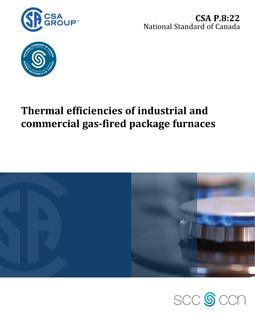Preface
This is the third edition of CSA P.8, Thermal efficiencies of industrial and commercial gas-fired package furnaces . It supersedes the previous editions published in 2009 by CSA Group and in 1997 by the Canadian Gas Association. The test method specified in this Standard is generally consistent with CSA/ANSI Z21.47/CSA 2.3, Gas-fired central furnaces, and CAN/CSA-P.2, Testing method for measuring the annual fuel utilization efficiency of residential gas-fired furnaces and boilers. However, the metric calculated by this Standard has been updated to take a holistic view of the energy efficiency of a packaged furnace, be more representative of total unit enclosure losses and their impact on energy consumption, and address energy consumption concerns related to ventilation. The major changes to this edition are the following: a) moving the test procedure metric from a metric measuring the unit efficiency for a single operating condition (steady-state at high and reduced fire, respectively) to a metric combining several operational modes (including off-modes) covering the energy usage across the entire heating season; b) accounting for losses from the entire packaged furnace enclosure (including the exterior cabinet and dampers), not just the furnace jacket; and c) performing heat losses calculations for an outdoor installation. Additional details on the changes to this Standard and the TCOP metric are included in Annex C. CSA Group acknowledges that the development of this Standard was made possible, in part, by the financial support of Natural Resources Canada (NRCan), Efficiency Manitoba, and FortisBC. This Standard is considered suitable for use for conformity assessment within the stated scope of the Standard. This Standard was prepared by the Subcommittee on Efficiency of Residential Gas-Fired Furnaces, Boilers, and Industrial and Commercial Package Furnaces, under the jurisdiction of the Technical Committee on Energy Efficiency and Related Performance for Fuel-Burning Appliances and Equipment and the Strategic Steering Committee on Performance, Energy Efficiency, and Renewables, and has been formally approved by this Technical Committee. This Standard has been developed in compliance with Standards Council of Canada requirements for National Standards of Canada. It has been published as a National Standard of Canada by CSA Group.
Scope
1.1 General This Standard specifies test methods and performance criteria for determining the heating season coefficients of performance (TCOPHS and GCOPHS) of weatherized and non-weatherized gas-fired package furnaces that might or might not include features that enable the provision of ventilation air and/or air cooling, in addition to space heating. This Standard also includes systems that have the primary function of providing ventilation air and that are capable of heating the ventilation air. This Standard is intended to provide “cold climate” performance criteria, which represents that of package furnaces used in the colder climates typically found in Canada and other northern locations.
1.2 Three-phase application This Standard applies to package furnaces using a three-phase power supply with input rates less than or equal to 2930 kW (10 000 000 Btu/h).
1.3 Single-phase application This Standard applies to package furnaces using a single-phase power supply with input rates greater than 65.9 kW (225 000 Btu/h).
1.4 Dual measurements The values given in SI units are the units of record for the purposes of this Standard. The values given in parentheses are for information and comparison only.
1.5 Terminology In this Standard, “shall” is used to express a requirement, i.e., a provision that the user is obliged to satisfy in order to comply with the Standard; “should” is used to express a recommendation or that which is advised but not required; and “may” is used to express an option or that which is permissible within the limits of the Standard. Notes accompanying clauses do not include requirements or alternative requirements; the purpose of a note accompanying a clause is to separate explanatory or informative material from the text. Notes to tables and figures are considered part of the table or figure and may be written as requirements. Annexes are designated normative (mandatory) or informative (non-mandatory) to define their application.
Product Details
- Edition:
- 3rd
- Published:
- 06/22/2022
- ISBN(s):
- 9781488343445
- Number of Pages:
- 67
- File Size:
- 1 file , 1.9 MB
- Product Code(s):
- 2428827, 2428827
- Note:
- This product is unavailable in Russia, Ukraine, Belarus
